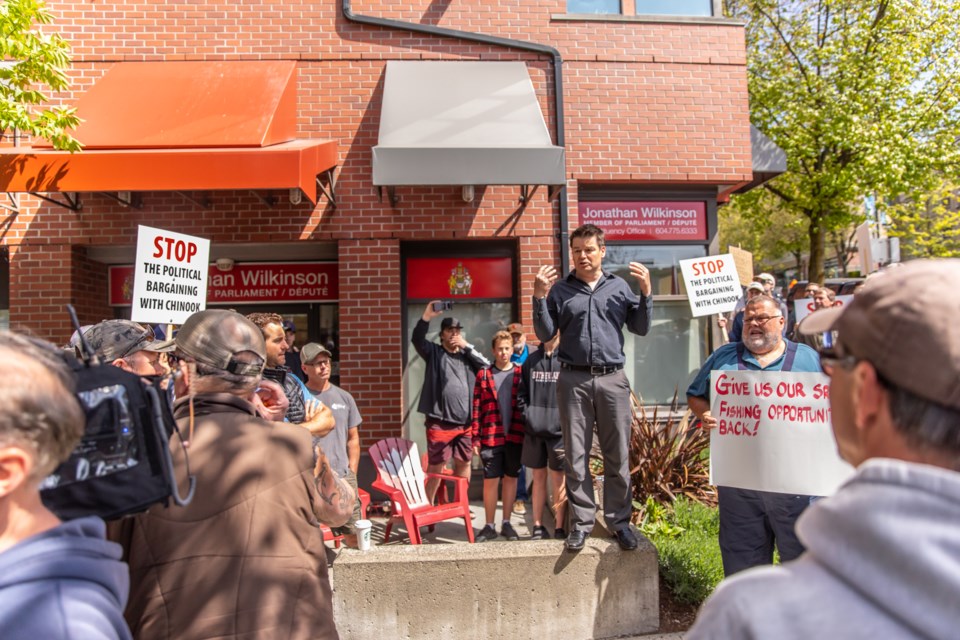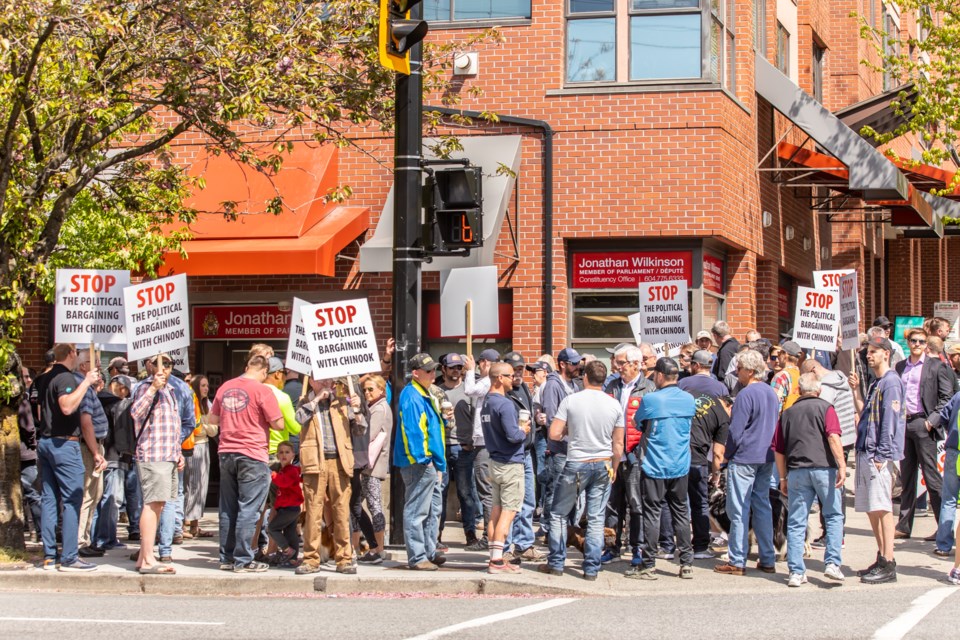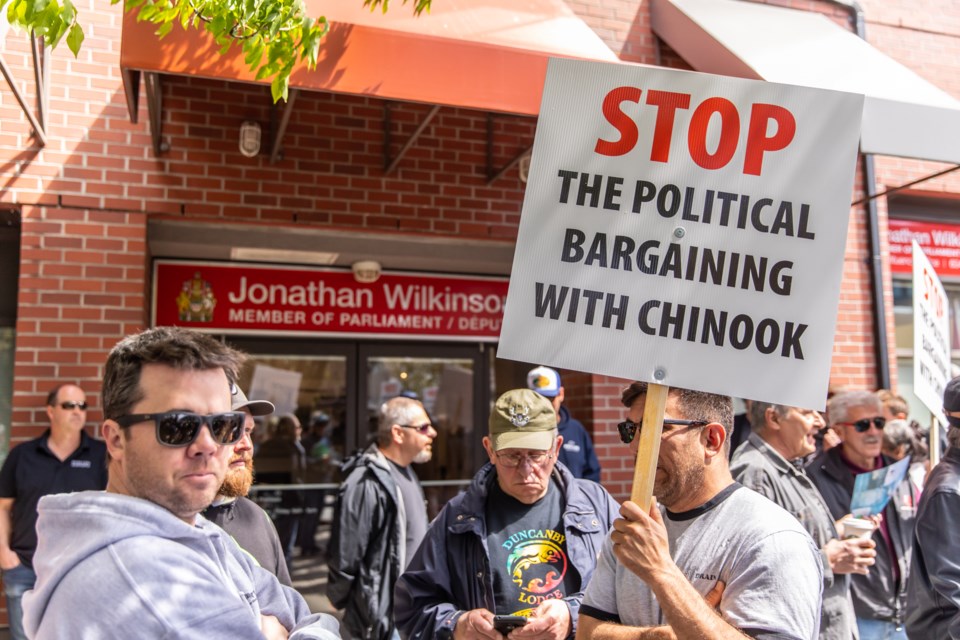A government decision to restrict fishing for at-risk Fraser River chinook salmon has sparked a passionate response from recreational anglers.
On Wednesday, about 200 demonstrators gathered outside the Lower Lonsdale constituency office of Fisheries Minister and North Vancouver MP Jonathan Wilkinson to show their dismay and ensure their voices were heard.
“Their idea of addressing the problem is one announcement, and it’s a real lack of action,” said Dave Brown, a recreational angler who helped organize the event. “This protest is drawing attention to the closure of this core fishery, but also the enormous lack of meaningful action by this department to recover salmon populations, and in particular these early Fraser timed chinook.”
The mandatory catch-and-release fishery for sport and recreational anglers was implemented on April 16 and will be in place until July 31. Beyond that, anglers will be restricted to one chinook per day. Chinook fishing in the Fraser River will be prohibited until at least late August.

The decision was made by the Department of Fisheries and Oceans in an effort to conserve chinook stocks.
In an emailed statement to the North Shore News, Wilkinson stated that he made the difficult decision after extensive consultation, and a thorough review of scientific evidence.
"As Minister of Fisheries and Oceans, Canadians expect me to make my decisions based on science and evidence, and ensure these endangered wild chinook stocks survive," stated Wilkinson. "The restrictions were mindful of what we have heard from recreational and commercial fisheries stakeholders."
Members of B.C.’s fishing community are still questioning the move.
“What we feel is it’s a political manoeuvre to appear that the Fisheries Minister and the department are actually doing something on chinook recovery, when they’re failing to address a number of factors that are impacting chinook salmon and specifically these stocks of concern.” explained Brown.
Brown points to climate change, the agricultural extraction of water, and the reduction of hatchery smolts as additional factors impacting at-risk stocks. He stressed that the decision will also have negative socioeconomic impacts on B.C.’s small coastal communities.
“What the government fails to recognize is the people in these communities are passionate, they care about their wild salmon,” said Brown.
Jason Assonitis, the owner of Bon Chovy Salmon Fishing Charters, told the North Shore News that he expects to lose 50 to 60 per cent of his business as a result of this decision.
Brown said about 9,000 jobs are related to the sport fishery.
“He (the minister) is painting all the chinook stocks with just one brush, when we’re talking about one distinct stock. There’s a whole bunch of stocks that are doing well, and that’s where the recreational sector had options to target these fish.” said Assonitis.
“You have spinoffs; from hotels, to boat dealerships, to mechanics, it’s not just us, there’s a whole carryover effect. One fishing charter off two people can be up to $20,000 in revenue they’re spending, just to catch one hatchery fish. But the government said no.”
According to Assonitis and Brown, less than one per cent of the chinook caught last year around the province were part of the at-risk stock.
“A group of us has been dedicated to DNA sampling for over six years now, and we have the data. When the federal government says we’re doing this based on science, we’re calling them out and saying ‘you’re not.’ We are the ones that help get all this data.”
After the demonstration, Brown told The Chief he is hoping Sea to Sky MP Pamela Goldsmith-Jones will help the organizers to get a meeting with the minister.
As a guy who doesn't typically attend protests, he was shocked and happy with the turnout, he said.
The event was a last resort, he said, adding the four organizers sat down five days before the protest and came to the conclusion it was the only way to get government attention.
"We've tried attending fishery sport advisory meetings, responding to DFO requests for feedback on whether they were going to go with Option A, which was the full closure, or Option B, which was the retention of one chinook... we tried speaking with Pam Goldsmith-Jones. I stopped into Jonathan Wilkinson's office twice starting in February in March," he said. "On April 16, it was just absolute shock."
Background
This protest comes after a series of events that began in February.
On Feb. 6, Fisheries and Oceans Canada asked for feedback on options for addressing decreasing chinook stocks. The government collected feedback until March 1 on whether a shutdown of the chinook fishery or a reduction of retention limits to one fish—would be best.
In March, after the Forums on Conservation and Harvest Planning, Ken Malloway, the Fraser River Aboriginal Fisheries Secretariat chairperson sent a letter to the DFO demanding action on behalf of First Nation participants at the forum.
The letter strongly suggested the DFO limit the sport fishery.
"Specifically, DFO has allowed commercial and recreational fishing activity when there is insufficient chinook to meet conservation goals and First Nations’ rights-based fishery needs," reads the letter by Malloway.
The letter also said some attendees were "ready to take direct action if needed, including litigation, to protect Fraser River salmon if DFO" didn't heed the advice.
On April 16, DFO announced the closures.
Brown said while some First Nations did call for the closure, others were not supportive of such action.
He pointed to the relationship user groups and the Squamish Nation have in the Sea to Sky Corridor as an example of how various members of the community who care about salmon work together well for the betterment of the species, collaborating on habitat projects in Squamish and beyond.
The Chief reached out to the Fraser River Aboriginal Fisheries Secretariat for a response to the closure, but has yet to hear back.




